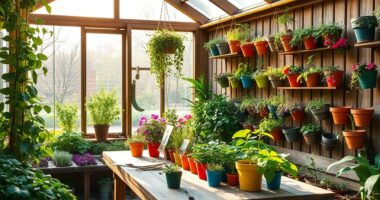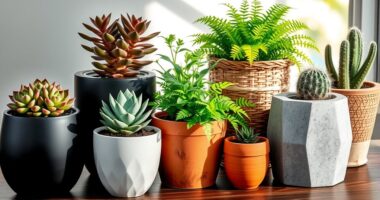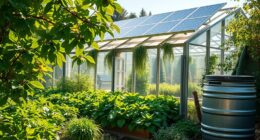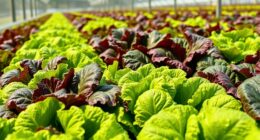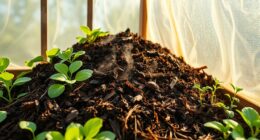If you're looking to elevate your gardening space, Edwardian greenhouses are a fantastic choice. With their elegant designs and practical features, they beautifully combine aesthetics with functionality. I love how ornate detailing and large glass panes enhance any garden. Plus, ample ventilation guarantees your plants thrive year-round. There are plenty of inspiring designs out there that can fit any garden style. Stick around, and I'll share more insights on selecting the perfect Edwardian greenhouse for you!
Key Takeaways
- Edwardian greenhouses feature ornate detailing and large glass panes, enhancing both beauty and functionality in any garden setting.
- Curved roofs in Edwardian designs promote effective rain drainage while adding an elegant aesthetic to the greenhouse.
- Ample ventilation options, including roof vents and side windows, are crucial for maintaining optimal growing conditions for plants.
- Customizable color schemes and materials allow Edwardian greenhouses to harmonize with diverse garden aesthetics and personal preferences.
- Incorporating shelving and growing beds into the design maximizes space and facilitates easier plant care within the greenhouse.
The Year-Round Solar Greenhouse Guide

If you're looking to maximize your gardening potential year-round, the "Year-Round Solar Greenhouse Guide" is perfect for you. This engaging book covers a range of greenhouse building methods that can extend your growing season. I found the discussions and clear explanations extremely helpful, especially since I'm handy and enthusiastic to immerse myself in practical implementations. The innovative concepts, like the underground piping system, really caught my attention. While it lacks some specific details, it opens doors to further exploration. Overall, this guide equips you with the confidence to create a thriving greenhouse, even in challenging climates.
Best For: Gardeners and DIY enthusiasts looking to build a year-round solar greenhouse to maximize their growing potential.
Pros:
- Engaging and well-written content that makes it easy to understand greenhouse building methods.
- Innovative design concepts like the underground piping system, enhancing year-round functionality.
- Comprehensive resources including diagrams and case studies that aid in the planning process.
Cons:
- Lacks full details for specific implementations, which may require additional research.
- Some readers may desire more in-depth exploration of certain techniques and topics.
- Primarily suited for those who are handy, as practical application may be challenging for novices.
Black & Decker Complete Guide to DIY Greenhouses

For anyone looking to immerse themselves in the world of greenhouse gardening, "Black & Decker The Complete Guide to DIY Greenhouses" stands out as an invaluable resource. This book offers detailed insights into building various structures, from greenhouses to cold frames. I found the extensive color photography and practical advice incredibly helpful, especially when considering essential features like flooring and ventilation. Many users rave about its clarity and construction plans, making it a favorite for DIY enthusiasts. Despite a few minor inaccuracies in measurements, the wealth of information here truly inspires and equips you for your gardening journey.
Best For: DIY enthusiasts and gardeners looking to build their own greenhouse or garden structures with comprehensive guidance and detailed plans.
Pros:
- Extensive color photography that enhances understanding and provides visual inspiration.
- Detailed construction plans that cater to a variety of greenhouse designs and sizes.
- Comprehensive information on essential features like flooring, ventilation, and heating options.
Cons:
- Some minor inaccuracies in measurements noted by users, necessitating careful double-checking.
- May be overwhelming for beginners due to the extensive amount of information provided.
- Limited focus on pre-made greenhouse options, which might not appeal to those seeking quick solutions.
How to Build Your Own Greenhouse: Designs and Plans
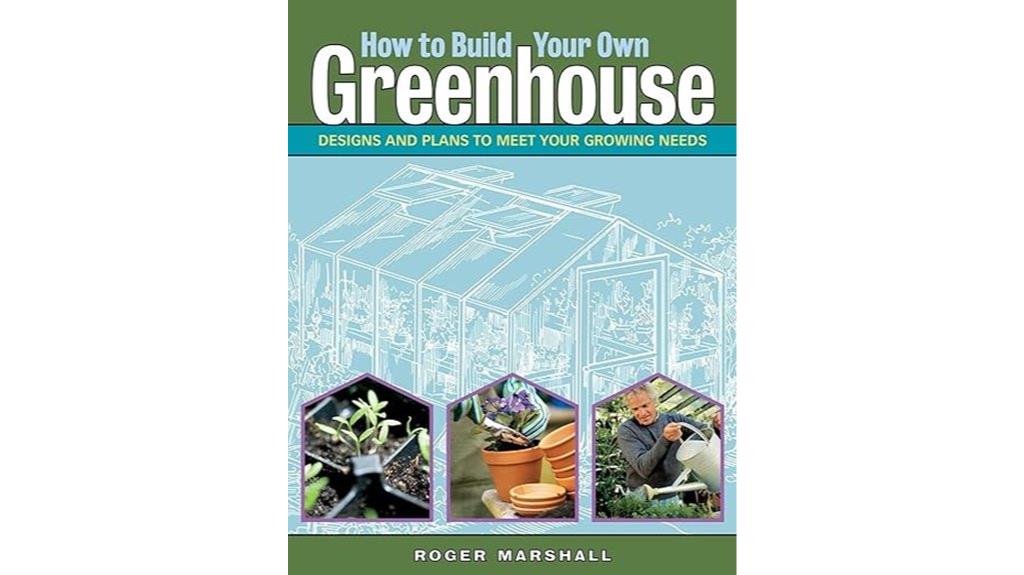
Building your own greenhouse can be a rewarding project, especially for those who want to cultivate plants year-round in a controlled environment. I found a thorough resource that covers everything from basic designs to advanced concepts, making it perfect for DIY builders. It addresses common challenges like humidity and material selection, ensuring you're well-prepared. While it briefly touches on aquaponics, it's still invaluable for various greenhouse projects, whether you want a simple cold frame or a sophisticated structure. I recommend exploring multiple books for a well-rounded understanding, but this one truly stands out for its practical guidance and clarity.
Best For: DIY builders of all skill levels looking for comprehensive guidance on greenhouse construction.
Pros:
- Provides thorough design considerations and practical guidance for various greenhouse projects.
- Accessible for both novices and experienced builders, addressing common challenges effectively.
- Offers insights for integrating aquaponics and retrofitting existing structures.
Cons:
- May be too detailed for those seeking simple greenhouse projects.
- Limited coverage on aquaponics, which could leave some readers wanting more information.
- Readers may need to consult additional resources for a broader understanding of greenhouse construction.
GREENHOUSE GARDENING FOR BEGINNERS: Complete Guide to Growing Vegetables and Fruits

Choosing the right greenhouse design can make all the difference for beginners enthusiastic to grow their own vegetables and fruits. With a greenhouse, I can extend my growing season and cultivate plants that wouldn't thrive outside. This complete guide has been a lifesaver, covering everything from selecting the perfect greenhouse to maintaining it efficiently. I appreciate the detailed crop guides, which help me avoid common mistakes and save money on produce. While it's primarily aimed at novices, I've found it invaluable for starting my first greenhouse garden. Just remember, hands-on experience is key to mastering greenhouse gardening!
Best For: This guide is best for absolute novices interested in starting their first greenhouse garden and learning the basics of growing vegetables and fruits.
Pros:
- Covers essential topics like selecting and maintaining a greenhouse, making it suitable for beginners.
- Includes detailed crop guides to help avoid common gardening mistakes.
- Helps save money on produce by enabling year-round cultivation.
Cons:
- May be too basic for those with some prior knowledge of greenhouse gardening.
- Lacks diagrams and practical tips, leading to unclear explanations.
- Content may be more applicable to commercial setups rather than casual home gardening.
10×14 FT Polycarbonate Walk-in Greenhouse
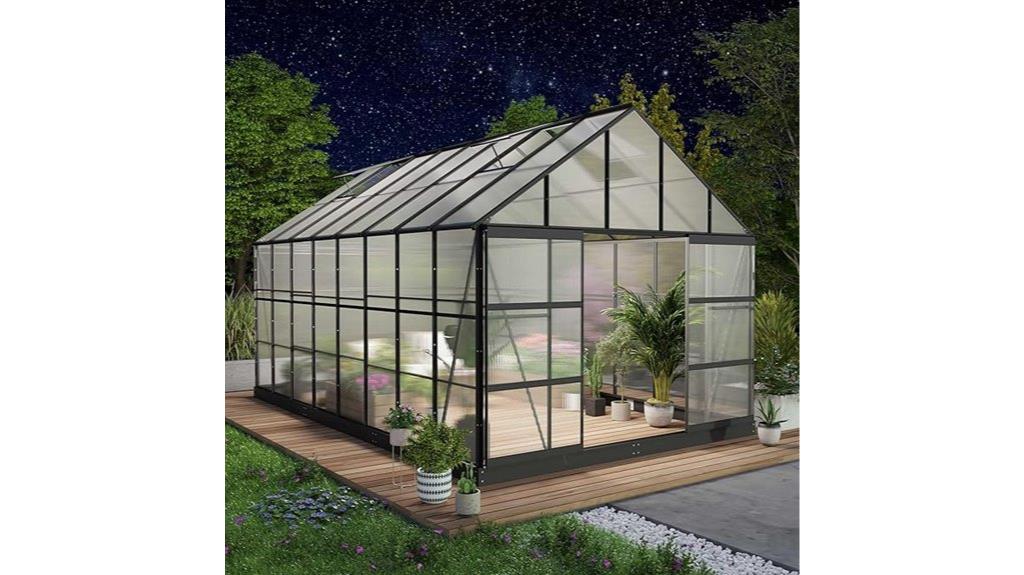
The 10×14 FT Polycarbonate Walk-in Greenhouse stands out for its robust aluminum frame and generous storage capacity, making it ideal for serious gardeners looking to cultivate a variety of plants. With a sturdy construction and a weight capacity of 960 lbs, it can handle your gardening ambitions. The UV-resistant 4mm polycarbonate panels block 99% of harmful rays while ensuring excellent light diffusion. I love the four height-adjustable roof vents that promote excellent air circulation. Plus, the double sliding doors provide easy access. This greenhouse truly maximizes space, allowing me to focus on nurturing my plants without hassle.
Best For: Serious gardeners looking for a spacious and durable greenhouse to cultivate a variety of plants.
Pros:
- Robust aluminum frame supports a high weight capacity of 960 lbs, making it suitable for various gardening setups.
- UV-resistant polycarbonate panels block 99% of harmful rays while providing excellent light diffusion for optimal plant growth.
- Height-adjustable roof vents and double sliding doors enhance ventilation and accessibility, promoting a healthy growing environment.
Cons:
- Heavy item at 240 pounds, which may require assistance for setup and relocation.
- Best Sellers Rank indicates it may not be a leading option compared to other greenhouses in the market.
- Warranty and support details are only available upon request, which may be inconvenient for some customers.
HOWE Pavilion Styled Greenhouse (16x12x9.5 FT)
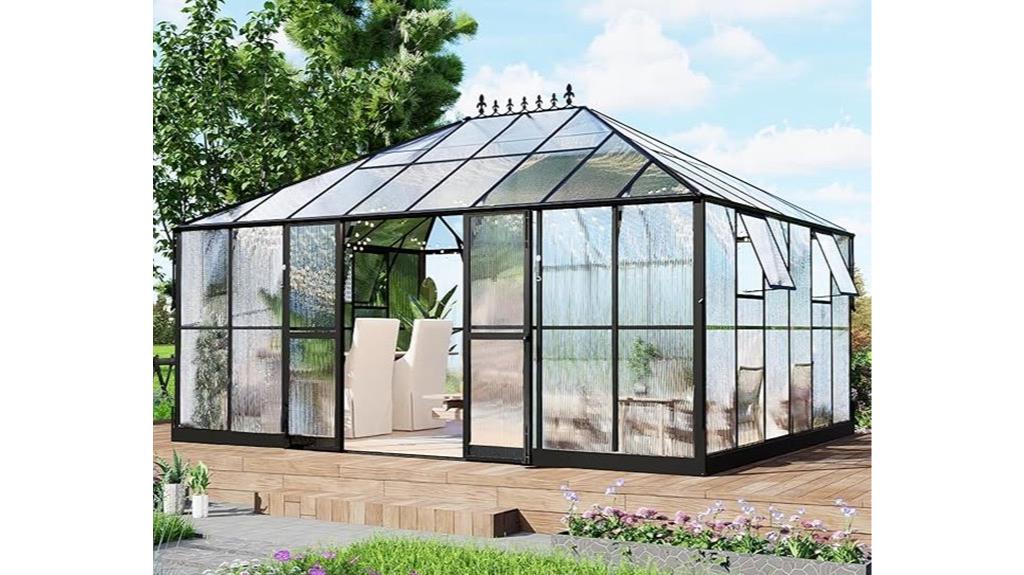
For anyone looking to elevate their gardening experience or create a stylish outdoor retreat, the HOWE Pavilion Styled Greenhouse (16x12x9.5 FT) stands out as an excellent choice. Its spacious design offers ample room for plant cultivation or even a cozy sunroom. With durable aluminum framing and polycarbonate walls, it's built to withstand challenging weather. I love the two lockable doors and four vent windows for easy access and ventilation. Although assembly can take some time, the sturdy construction and positive customer feedback make it a worthwhile investment for any gardening enthusiast. You won't regret adding this beauty to your yard!
Best For: Gardening enthusiasts or homeowners looking for a stylish and spacious outdoor greenhouse to cultivate plants or create a sunroom.
Pros:
- Sturdy aluminum frame and polycarbonate walls ensure durability and weather resistance.
- Generous space (16×12 FT) allows for versatile plant cultivation and other uses.
- Positive customer feedback highlights strong construction and effective ventilation.
Cons:
- Assembly can be time-consuming, taking 15-25 hours depending on experience.
- Instructions may lack clarity, leading to mixed reviews on assembly guidance.
- Some users have noted inefficiencies with the window locking mechanisms.
AMERLIFE Polycarbonate Greenhouse (10x14x8.4 FT)

Looking for a durable greenhouse that marries modern functionality with classic design? The AMERLIFE Polycarbonate Greenhouse (10x14x8.4 FT) might just be what you need. Its unbreakable panels offer exceptional UV protection, while the heavy-duty aluminum frame guarantees sturdiness. With four adjustable skylights and rain gutters, it promotes excellent ventilation and drainage. Plus, the sliding doors make access easy. I appreciate that it can serve multiple purposes, from gardening to casual gatherings. While assembly takes a bit of teamwork, the solid construction stands up to challenging weather. Overall, it's a versatile addition to any gardening oasis!
Best For: Those seeking a durable and versatile greenhouse for gardening, casual gatherings, or storage.
Pros:
- Unbreakable polycarbonate panels provide exceptional UV protection and durability.
- Heavy-duty aluminum frame ensures sturdy construction, even in adverse weather conditions.
- Four adjustable skylights and rain gutters promote excellent ventilation and effective drainage.
Cons:
- Assembly may require a team and can take approximately 12 hours.
- Mixed reviews on the clarity of the assembly instructions.
- Limited customer ratings may indicate a need for more user feedback.
DREAM GREENHOUSE FOR BEGINNERS: ULTIMATE COURSE ON BUILDING AND OPERATING A GREENHOUSE

If you're a beginner keen to plunge into greenhouse gardening, "Dream Greenhouse for Beginners" stands out as the ideal resource. This all-encompassing guide walks you through building and maintaining your greenhouse, ensuring you understand costs and upkeep. You'll find step-by-step instructions on site selection and construction, tailored to your local climate. The book also covers essential climate control, irrigation, and maintenance tips, making your gardening experience enjoyable. Plus, it offers insights on selecting the right plants and managing nutrients. I highly recommend this well-organized, engaging guide for anyone looking to cultivate a thriving greenhouse garden.
Best For: Beginners who want to learn how to build and operate a greenhouse for year-round gardening.
Pros:
- Comprehensive guide covering all aspects of greenhouse construction and maintenance.
- Step-by-step instructions tailored to various climates and locations.
- Clear information on plant selection and nutrient management for successful gardening.
Cons:
- May be overwhelming for absolute novices due to the amount of information.
- Limited advanced techniques for seasoned gardeners looking for more in-depth strategies.
- Initial setup costs may be a concern for some beginners.
CDCASA Greenhouse for Outdoors
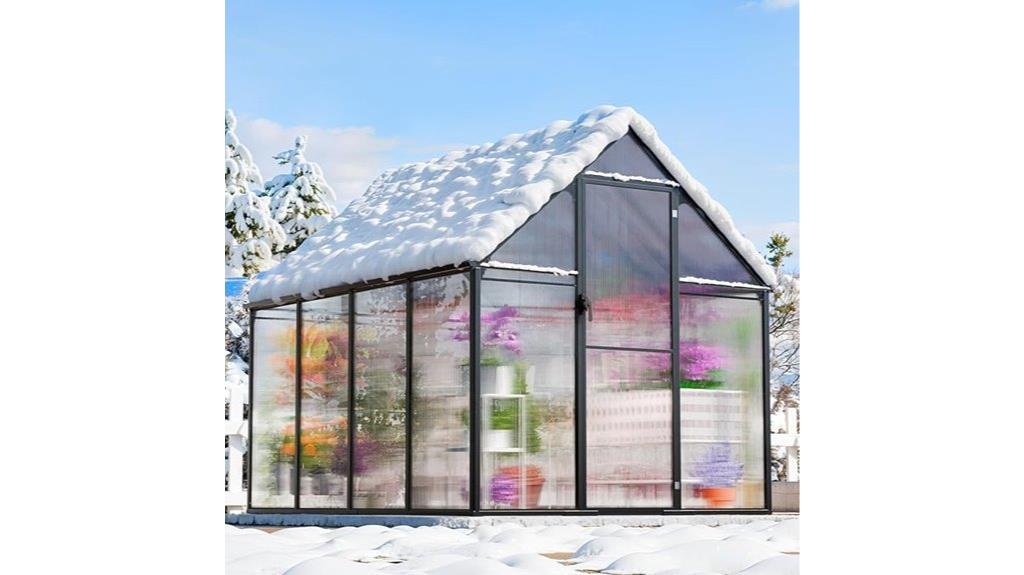
The CDCASA Greenhouse for Outdoors stands out as an ideal choice for gardeners seeking a sturdy and stylish solution for their plant care. With dimensions of 8.2×6.2 feet, it's spacious enough for various plants. The aluminum frame and 4mm polycarbonate panels guarantee durability while blocking harmful UV rays. I appreciate its four ventilation options, which keep airflow consistent. Although assembly can be tricky due to vague instructions, the innovative Quick Connect technology speeds things up. Just be aware of potential stability issues in high winds; some users recommend adding extra supports. Overall, it's a solid investment for any gardening enthusiast.
Best For: Gardeners looking for a durable and stylish greenhouse solution to maintain plant health in various weather conditions.
Pros:
- Sturdy aluminum frame and 4mm polycarbonate panels provide excellent durability and UV protection.
- Four adjustable vent options ensure proper airflow and temperature control for plants.
- Quick Connect technology simplifies assembly, reducing setup time significantly.
Cons:
- Assembly instructions are often unclear, which may lead to confusion during setup.
- Some users report stability issues in high winds, suggesting the need for additional support.
- Gaps caused by panel lengths can compromise the greenhouse's overall stability.
UMIG 6 PCS Polycarbonate Greenhouse Panels

For anyone seeking to enhance their Edwardian greenhouse experience, the UMIG 6 PCS Polycarbonate Greenhouse Panels stand out due to their exceptional thermal insulation capabilities. Measuring 6 ft by 2 ft, these durable panels are impact-resistant and provide 80% light transmission, ensuring my plants get the light they need without compromising on safety. I love that they're easy to cut for custom applications, making them versatile for various projects like patio awnings or garden fences. With a solid 4.8-star rating and a warranty available, I feel confident investing in these panels to elevate my gardening oasis.
Best For: Gardeners and outdoor enthusiasts looking for durable, versatile greenhouse panels that provide excellent thermal insulation and light transmission.
Pros:
- Lightweight and sturdy design makes installation easy and efficient.
- High impact resistance ensures durability and long-lasting performance.
- Customizable size allows for various applications beyond greenhouses, such as patio awnings and garden fences.
Cons:
- Some customers suggest that thicker panels might offer better insulation.
- Requires a utility knife for cutting, which may not be readily available to all users.
- Limited warranty information may cause uncertainty for some buyers regarding long-term support.
Factors to Consider When Choosing Edwardian Greenhouse Designs
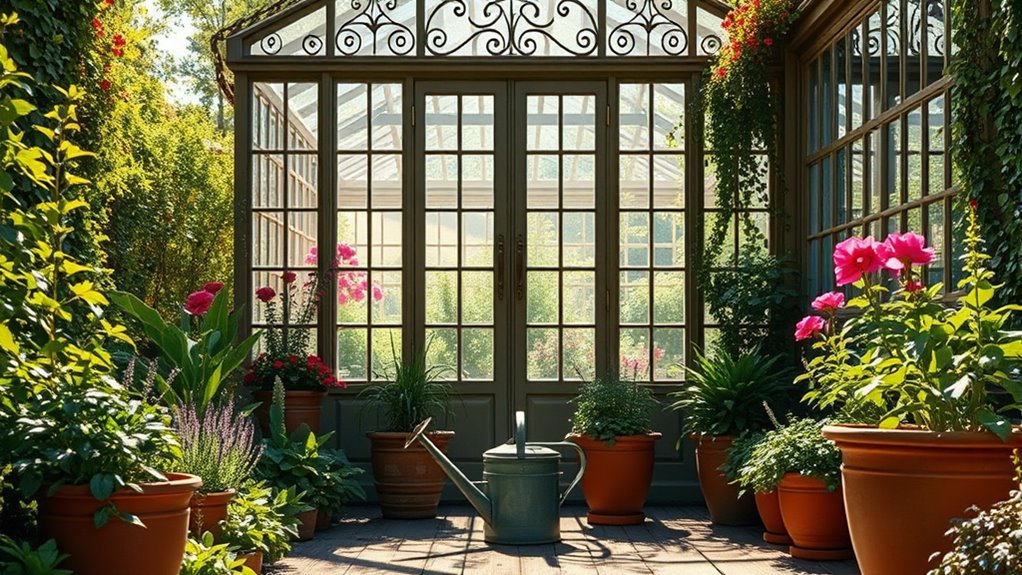
When I think about choosing an Edwardian greenhouse design, several key factors come to mind. I consider structural integrity, ventilation, and the materials used, as these all play an essential role in the greenhouse's performance. Plus, I can't overlook the aesthetics and how well it fits into my space.
Structural Integrity and Stability
Choosing an Edwardian greenhouse design involves careful consideration of its structural integrity and stability, especially since these factors can greatly affect its longevity and performance. I've found that using durable materials like aluminum or treated wood frames is vital, as they provide the necessary strength to withstand various weather conditions. Proper anchoring is also important; designs with ground stakes or anchor bolts can markedly enhance stability against wind loads. Additionally, a well-designed roof helps distribute snow load evenly, preventing areas from bearing excessive weight. I always prioritize regular maintenance and inspections to guarantee connections and seals remain secure, which helps prevent deterioration over time. By focusing on these elements, I can create a resilient gardening oasis.
Ventilation and Airflow
Effective ventilation is one of the most essential aspects I consider in Edwardian greenhouse designs. It's vital for maintaining ideal temperature and humidity levels, which helps prevent plant stress and diseases. I love incorporating adjustable roof vents and side vents, as they allow for controlled airflow and reduce the risk of overheating in warmer months. Proper airflow design also manages excess moisture, minimizing mold and fungal growth on my plants. Plus, I strategically place ventilation openings to take advantage of prevailing winds, enhancing natural cooling. A well-ventilated greenhouse not only supports healthy transpiration rates but also improves pollination and promotes stronger plant growth. These features guarantee my gardening oasis thrives throughout the seasons.
Material Durability and Insulation
While considering Edwardian greenhouse designs, I always focus on material durability and insulation, as they play an essential role in the longevity and efficiency of the structure. I prefer materials like aluminum and polycarbonate, which resist rust and UV degradation. Insulation is crucial for stable temperatures; I find that double-layer polycarbonate panels greatly enhance thermal insulation, keeping the interior cozy in winter and cool in summer. The thickness of the panels matters, too—thicker options around 4mm to 6mm provide better thermal performance and reduce heat loss. Additionally, I make sure to use high-quality gaskets for proper sealing, improving the airtightness of my greenhouse, which ultimately boosts energy efficiency. Finally, I consider local climate conditions when choosing materials.
Design Aesthetics and Functionality
When I think about the design aesthetics and functionality of Edwardian greenhouses, I'm captivated by how their ornate detailing and large glass panes create a stunning focal point in any garden. The elegant curved roofs not only enhance their beauty but also guarantee effective rain drainage and snow shedding, which is vital for longevity. Ample ventilation options, like roof vents and side windows, help maintain ideal temperature and humidity for plant growth. I appreciate how the layout often includes designated areas for shelving and growing beds, making it easier to care for my plants. Plus, I can customize the color schemes and materials to harmonize with my garden, blending practicality with visual appeal effortlessly.
Space and Accessibility Considerations
Choosing the right Edwardian greenhouse design starts with understanding your available outdoor space. I always make sure the structure fits seamlessly into my garden without crowding or blocking pathways. Accessibility is key; I pay close attention to door placements and pathways, ensuring I can easily move around while tending to my plants or transporting tools. The height of the greenhouse matters too, especially if I want to grow taller plants. I also evaluate the layout for maximum sunlight exposure, as it's essential for plant health. Finally, I incorporate ventilation options like windows and vents within easy reach, so I can control airflow and temperature without straining. These considerations make my gardening experience enjoyable and efficient.
Frequently Asked Questions
What Materials Are Best for Building an Edwardian Greenhouse?
When I think about the best materials for building an Edwardian greenhouse, I always lean towards sturdy aluminum or traditional wood frames. They offer durability while maintaining that classic aesthetic. For the glazing, glass is a must; it lets in maximum sunlight. I've found that using double-glazed panels improves insulation too. Ultimately, it's all about blending functionality with that charming, vintage look that makes gardening in it a joy.
How Do I Maintain Temperature in an Edwardian Greenhouse?
Maintaining the perfect temperature in my Edwardian greenhouse is like orchestrating a delicate symphony. I rely on a mix of natural ventilation, shading, and hot water heating for those chilly days. I open the windows when it's warm, use shade cloths to protect against harsh sunlight, and keep an eye on the thermostat. It's all about creating a cozy environment for my plants to thrive, and I love every moment of it!
Are Edwardian Greenhouses Suitable for All Climate Types?
I've found that Edwardian greenhouses can be quite versatile, but their suitability really depends on your local climate. In milder regions, they thrive beautifully, offering a perfect balance of sunlight and ventilation. However, in extreme climates, you might face challenges. I'd recommend adding insulation or heating for colder areas and shading for hotter ones. Ultimately, with the right adjustments, you can create a productive environment regardless of your climate conditions.
What Plants Thrive Best in an Edwardian Greenhouse?
In my experience, an Edwardian greenhouse is perfect for a variety of plants. I've found that tomatoes, peppers, and cucumbers thrive in the warm, humid conditions. Herbs like basil and thyme also do well. For flowers, I love growing geraniums and petunias; they really brighten up the space. With the right care, you can create a lush environment that supports many different plants, making your greenhouse a vibrant oasis.
How Much Does It Cost to Build an Edwardian Greenhouse?
Building an Edwardian greenhouse can vary quite a bit in cost. I've found that basic kits start around $1,500, while custom builds can exceed $10,000 depending on size and materials. I'd recommend budgeting for quality glass and solid framing to guarantee durability. Don't forget about additional expenses like foundations, heating, and ventilation. It's wise to get quotes from several builders to find the best deal that fits your vision and needs.
Conclusion
In exploring these Edwardian greenhouse designs, I've realized how they can transform any garden into a personal oasis. Imagine stepping into a space where your plants thrive year-round, sheltered in elegant architecture. Choosing the right design isn't just about aesthetics; it's about nurturing life. So, as you commence on this gardening journey, ask yourself: what kind of sanctuary do you want to create? With the right inspiration, your dreams can blossom into reality.


